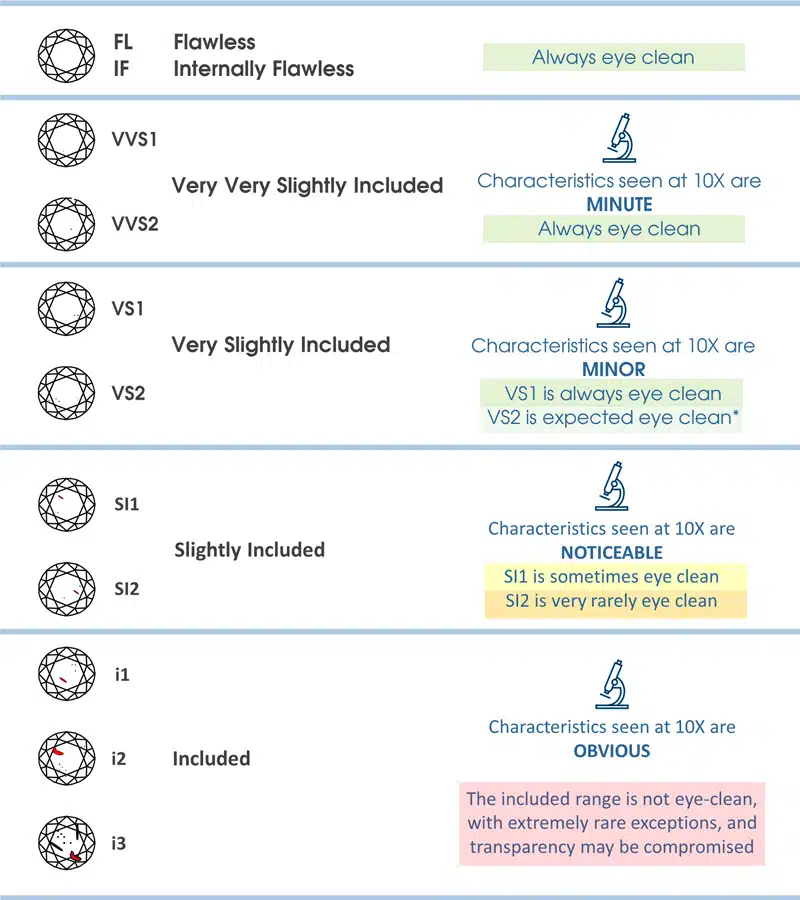Diamond Clarity Chart with Eye-Clean Definition
In Diamond 4Cs analysis, clarity evaluates a gemstone’s relative freedom from inclusions and blemishes. There are 11 different clarity grades which descend gradually from flawless. However, nuanced gemological analysis notwithstanding, many buyers just want to know, is it “eye-clean?”
11 Clarity Grades
Like snowflakes, every diamond is different. Spoiler alert: Even flawless diamonds, graded using 10X magnification, can display characteristics when you zoom in to 20X, 30X or beyond. Gemologists consider visibility at 10X, along with the number, size, color, nature, and location of its inclusions and blemishes when deciding a diamond clarity grade. For example, a diamond which has a number of large opaque crystals grouped under the table will be relegated to a much lower grade than a diamond with a single tiny pinpoint hidden near the edge.

“…Who cares about that stuff?”
Everyone cares about this except, perhaps, the end consumer. Diamond miners, rough traders, producers, grading laboratories, wholesalers and professional jewelers not only care about these details, each of the 11 clarity grades impacts a diamond’s value differently. The predicted clarity grade is calculated into the price miners and rough traders charge producers. The final clarity grade will ultimately be determined by a grading laboratory, and that grade along with the other Cs determines the diamond’s value the rest of the way, from wholesaler to jeweler to consumer.
“…Okay, but is the diamond EYE CLEAN?”
That’s the thing. Many people just want to know whether they’ll see something in the diamond they’re considering. When shopping in stores the question is quickly answered by looking at the diamond. With more and more people doing research and buying online, however, the question is not as easy to answer. “Will I see something in this diamond or not?” Meaning, will it be “eye-clean?”
Eye-Clean Definition
Traditional 4Cs assessment was not designed to assess whether a person can see its inclusions. Human eyesight varies. Distance, viewing direction and lighting also impact whether a diamond’s inclusions can be seen by a given person. Nevertheless, while IGI and other laboratories don’t make an eye-clean judgement, a survey of gemologists by the PriceScope.com community resulted in this consensus:
Eye-Clean: No inclusions visible to the unaided eye when viewed from the face up position in daylight equivalent or fluorescent lighting between 6-12 inches from the eye using 20/20 vision.
Eye-Clean Clarity Chart
By that definition: When graded according to internationally accepted standards, round brilliant diamonds with VS2 clarity and higher are reliably eye-clean. For shapes which show inclusions more easily, such as step cuts like emeralds and Asschers, VS2 clarity should be checked on a case by case basis. For round brilliants weighing over 3.00 carats, VS2 diamonds should also be checked on a case by case basis.

Hidden Treasure
Determined shoppers seeking eye-clean diamonds often find “hidden treasure” in the SI1 and SI2 grades – diamonds with no visible inclusions, just as clean as VS, VVS and Flawless diamonds to the naked eye, for a far lower spend. YES!

Exceptions
Human eyesight varies. That’s why the eye-clean definition given above stipulates 20/20 vision. This is normal visual acuity (seeing at 20 feet what should be seen at that distance). Some people have greater acuity than normal and may perceive subtle details the average person cannot detect. Alternately, those with weaker visual acuity may struggle to detect what the average person can see. Nearsighted people (myopic) also tend to have greater lifetime experience doing close-up analysis than those who are farsightedness (hyperopic) and may be more clarity-sensitive than people with normal visual acuity.
Clarity and Advancing Age
Great news for everyone in their 50s and older. All human beings are subject to the effects of presbyopia as we age. This is an increasing degree of farsightedness caused by loss of elasticity of the lens of the eye. It’s why you may not be able to read the print on a dime any longer – but it also means many of the diamond inclusions you could spot in your 20s and 30s will now be invisible. YES, AGAIN!

Clarity Grading Process
A gemologist analyzes clarity by looking down through the top of the stone at 10-power magnification. All inclusions and blemishes seen at 10-power are considered when deciding the clarity grade.
- A gemstone with no characteristics visible at 10 power magnification, is considered flawless, and a gemstone with surface blemishes but no inclusions can be graded internally flawless.
- A stone with minute characteristics, difficult to find even at 10 power, is Very Very Slightly Included. VVS1 is closest to flawless, followed by VVS2, which is still quite rare.
- A stone with minor characteristics seen at 10 power magnification, is Very Slightly included, also divided into VS1 and VS2.
- A stone with characteristics quickly noticeable at 10 power is Slightly Included, divided into SI1 and SI2.
- And finally, stones with characteristics large or abundant enough to be obvious at 10 power magnification (and possibly without magnification) are considered “Included.” Divided into I1, I2 and I3.
In addition to visibility at 10 power magnification, gemologists also consider Location, Number, Color, Size and the Nature of inclusions and blemishes when deciding the final clarity grade.
Applied practically: the Nature of a pinpoint (like a tiny speck) is benign, but the Nature of a feather (a crack in the crystal) may reduce the clarity grade beyond its visibility implications – potentially to the lowest “Included” grades, should it threaten the diamond’s durability.


Leave a Reply
Want to join the discussion?Feel free to contribute!